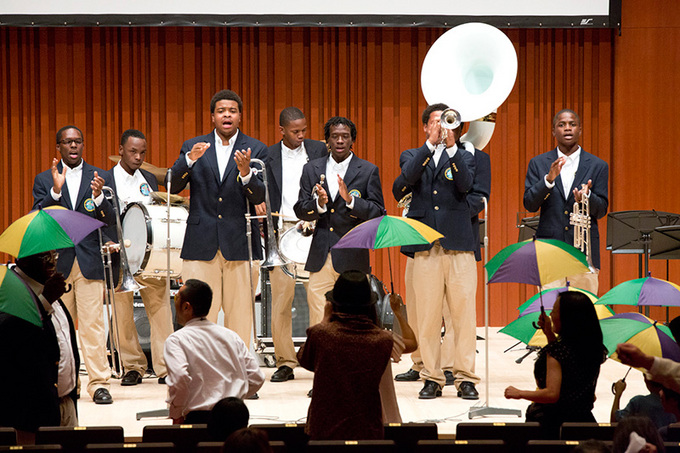Dreaming of Satchmo--Jazz Creates the Bond of Friendship between Japanese and American Youth
Kenji Matsumoto
Americas Section, Arts and Culture Department
The Japan Foundation
Oh, when the saints go marching in
Oh, when the saints go marching in
Oh, Lord, I want to be in that number
When the saints go marching in
A group of young musicians from New Orleans, the home of jazz music, sing at the top of their voices to a powerful beat. The music echoes under the beautiful clear sky of Kesennuma, a city of Miyagi Prefecture in Tohoku region that was devastated by the Great East Japan Earthquake of March 11, 2011. The group's co-performers, elementary and middle school students from local junior jazz orchestra the Swing Dolphins, had been shy during the closed exchange session. However, when standing in front of the big audience, they confidently perform a set piece titled Second Line alongside their American elders, dancing and waving handkerchiefs and twirling colorful parasols as they rehearsed. The crowd beams with smiles and cheers on the parade with enthusiastic rounds of thank yous.
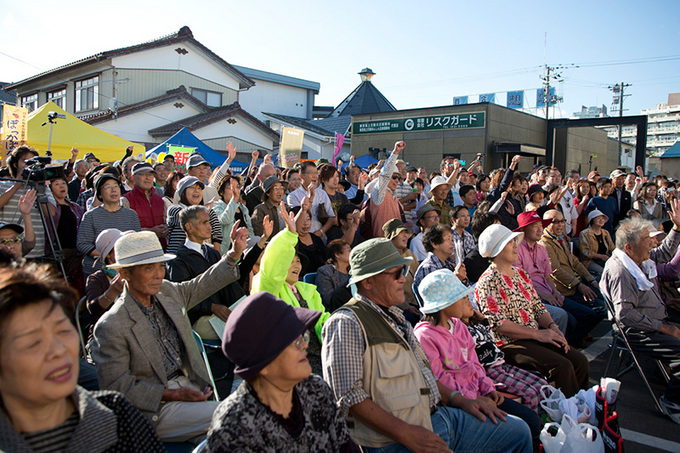
Kesennuma Street Live Music Festival
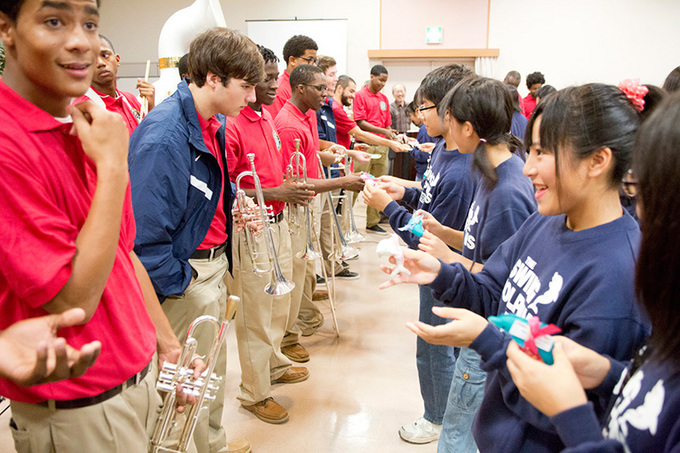
Gifts from Kesennuma's Swing Dolphins
Only one month after the disaster, musical instruments were delivered from New Orleans to the Swing Dolphins, whose members had suspended band activities after their gear was washed away by the tsunami. The gift represented an act of repaying the kindness for the many instruments sent from Japan to children in New Orleans over the years, and for the 10 million yen in donations following Hurricane Katrina, which swept the southeastern part of the United States and flooded the city of New Orleans in August 2005. All those efforts came from Yoshio and Keiko Toyama of the Wonderful World Jazz Foundation.
The Toyamas aspired to host an exchange program for young jazz players in Japan and the United States whose lives were affected by major natural disasters. They won the sympathy of organizations in both countries, including Tipitina's Foundation and the Miyagi Music Support Network, and eventually made their hope come true. In early October, a total of 16 performers from Tipitina's Intern Band and O. Perry Walker's Chosen Ones Brass Band were invited to cross the Pacific and visit Japan. During the tour in Miyagi Prefecture, they held exchanges with the Ishinomaki Junior Jazz Orchestra (Ishinomaki City), the Swing Dolphins (Kesennuma City), the Bright Kids (Tagajo City), and the Tohoku Gakuin Middle School/High School Wind Ensemble/ Marching Band (Sendai City).
Though circumstances differ by city, the children following their passion for music amid difficulties appear to be optimistic and to have a clear sense of their situation. The leader of the Swing Dolphins offers a short speech. "Thank you for coming to Kesennuma. Last year, the tsunami took away my home, and I couldn't see my mother for three days. Luckily, all my family members were safe. I was sad that my hometown was badly damaged, but it made me really happy when the instruments arrived from New Orleans. My dream is to be a trumpet player. I will practice hard, and hopefully one day I can visit New Orleans."
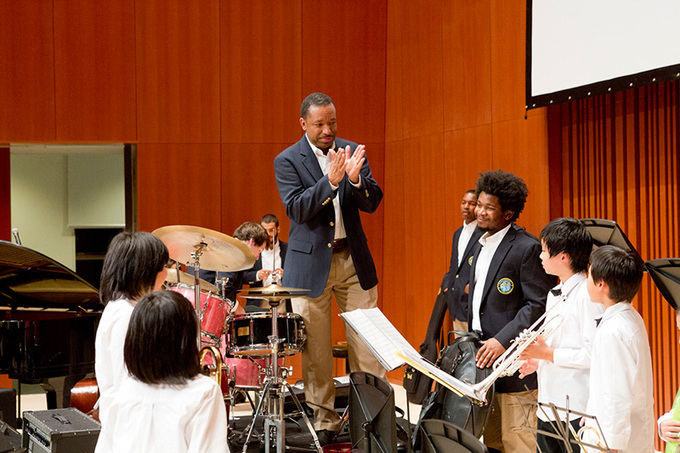
With elementary school jazz band Bright Kids

(Left) With Ishinomaki Junior Jazz Orchestra
(Right) Workshop in Ishinomaki City, Miyagi
Good educators and guardians support these children, at a great extent, to make strides toward their future through music for emotional nourishment. The words of Joichi Suto, director of the Swing Dolphins for nearly 20 years, leave a deep impression on me. "Culture and music are like a far-reaching, deep-rooted trunk. Their branches stretch a great deal, and they help to connect us with different people. Today, a helping hand came all the way from the other side of the globe. It offered the children a once-in-a-lifetime experience I never thought was possible right after the disaster. If we keep playing our instruments, someone somewhere who loves music will be listening. They will help us when we're in trouble, and we would be happy to return the favor. It will make me even happier if this exchange lasts forever."
Mr. Suto continues "We in Japan are still groping for a way to rebuild our lives after the catastrophe. One day, time will come when we need to change direction or settle on a course. That will be the day when these children who know the joy of blowing the horn need to take the lead. I feel it's the responsibility of adults to raise them into unflinching, persevering, helpful members of society. The sole focus of reconstruction efforts seems to be on infrastructure. But the same amount of energy needs to be poured into fostering people."
My conversation with Mr. Suto is cut off when the children start cheering. The bus is pulling out, carrying the New Orleans jazz band to the next stop on the tour. The Dolphins members are waving goodbye with all their might, and the handsome musicians from New Orleans are leaning out of the bus windows and waving back. After spending a whole day together, they have become friends at last, and seem reluctant to part. The sight brings back the bittersweet memories of youth.

(Left) Welcome message from Tohoku Gakuin
(Right) Performance at Tohoku Gakuin
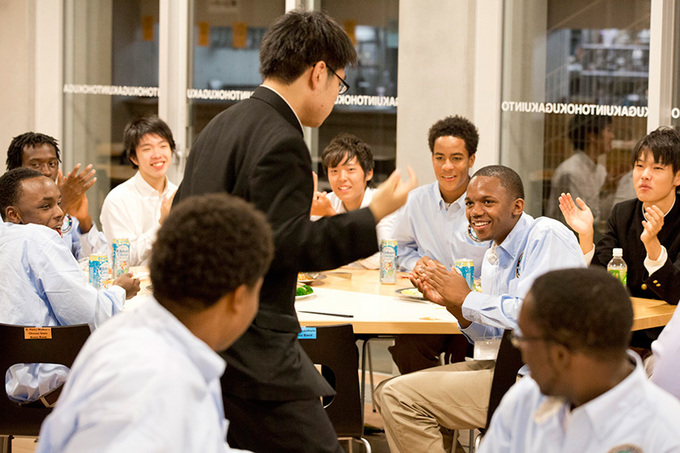
Exchange session at Tohoku Gakuin
I wonder how the high school students from the United States felt about the tour. They had been performing and traveling non-stop since they landed, and I worry that they couldn't have a moment to enjoy their first visit to Japan. At the briefing session and mini concert in Tokyo, holding a certificate of thanks from the Japanese Minister of Reconstruction, the musicians voiced their unanimous view of the trip. "The people of Japan value courtesy and hospitality, qualities we tend to overlook in our daily lives. I was inspired by this visit and felt I want to learn to be considerate of others, too." "The concerts were fantastic. So many people striving to recover from the disaster came to see us. I felt that our performance could give everyone a spark of energy." "The children in Japan's disaster-stricken areas are experiencing what we once went through. I think we've been able to deliver hope and inspiration. And I hope we've repaid some of the kindness we received from Japan." "The Japanese children love the same music we love. Our styles and interpretation of tunes are a bit different, but our common love of jazz has made us friends."
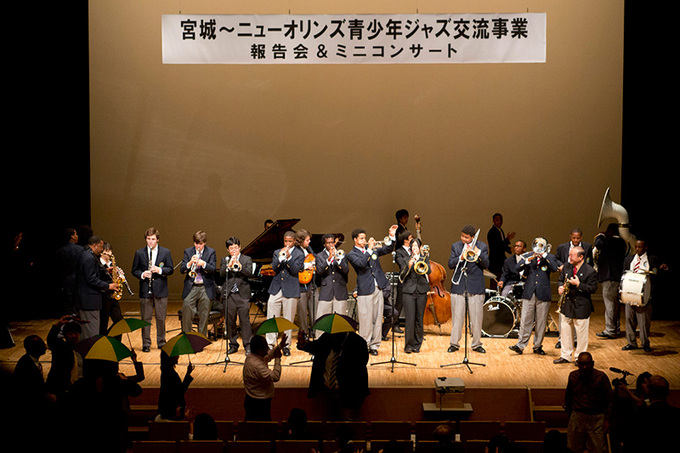
Briefing session and mini concert
Many of the New Orleans students suffered from the floods caused by Hurricane Katrina in their elementary school years. Having been forced to live in evacuation centers, they must have related themselves to the plight of the survivors in Tohoku region in Japan. Their situation and ours are different, and yet the same. Music has the power to unite people. Nothing would be more wonderful if the program inspired the participants of both countries to feel the power of music from the bottom of their hearts.
Last but not least, let us not forget that the Japan-U.S. dream exchange program sprung from the love and passion of jazz trumpeter Yoshio Toyama and his wife and banjo and piano player, Keiko. The couple met at the Waseda University New Orleans Jazz Club. In their youth, they traveled to New Orleans to study jazz music in the hometown of the king of jazz Louis "Satchmo" Armstrong they were longing for. For over 40 years since, they have maintained close ties with the friends they made in the city. In 1992, with the tragic shooting of a Japanese exchange student in Baton Rouge, Louisiana, they launched the "Horns for Guns" movement, and during the two decades since have donated more than 800 instruments to children in New Orleans. The Toyamas' candor and friendliness and their long years of commitment have made possible the exchange of kindness across the ocean between the disaster-stricken areas of Japan and the U.S.
The saints from New Orleans who marched in to the Tohoku region--what dreams did they have on the flight back home? And the jazz enthusiasts in Tohoku--what wish did they make upon a star? The Toyamas now harbor a new aspiration: to bring the Swing Dolphins to New Orleans next year and offer them an opportunity to experience the birthplace of jazz music. In the late years of his life, Louis Armstrong recorded the hit song "What a Wonderful World." Armstrong must be hoping from heaven that music exchange will continue forever to create a wonderful world.
Photographs: Kenichi Aikawa
A Jazz Journey to Tohoku: Miyagi-New Orleans Youth Jazz Exchange Program
Video filming and direction: Yasuhiro Tamura
Related Events
Keywords
- Music
- Social Securities/Social Welfare
- Japan
- United States
- Jazz
- New Orleans
- The Swing Dolphins
- Great East Japan Earthquake
- Hurricane Katrina
- Wonderful World Jazz Foundation
- Yoshio Toyama
- Keiko Toyama
- Tipitina's Foundation
- Miyagi Music Support Network
- Tipitina's Intern Band
- O. Perry Walker's Chosen Ones Brass Band
- Ishinomaki Junior Jazz Orchestra
- Bright Kids
- Tohoku Gakuin Middle School/High School
- Kesennuma
- Tagajo
- Sendai
- Louis Armstrong
- Waseda University
Back Issues
- 2025.9.30 The 51st Japan Found…
- 2025.9.30 The Japan Foundation…
- 2025.9.30 Bringing the World C…
- 2025.9.30 The 51st (2024) Japa…
- 2025.9.30 Japan Foundation Pri…
- 2024.5.24 The 50th Japan Found…
- 2024.3. 4 Movie Theaters aroun…
- 2023.4.10 The 49th Japan Found…
- 2023.3.28 JF's Initiatives for…
- 2023.1.27 Living Together with…


